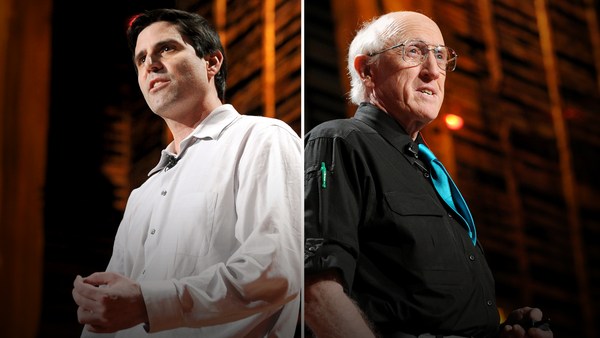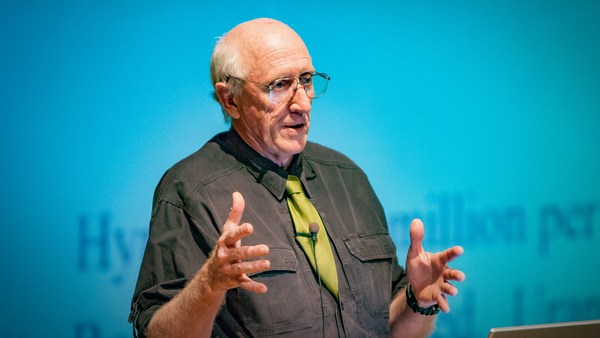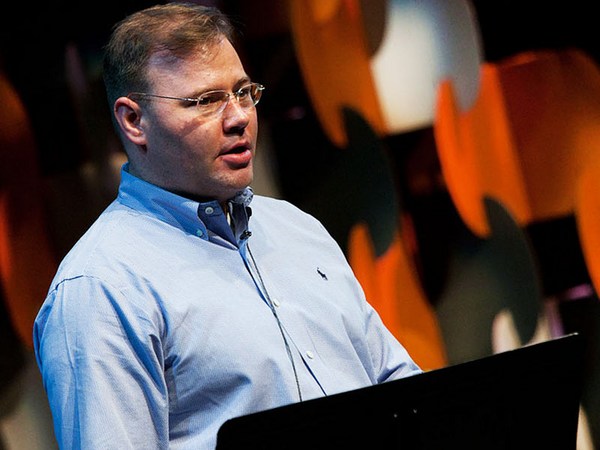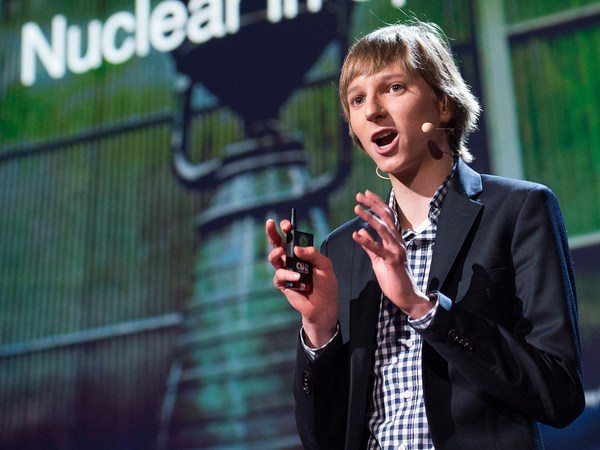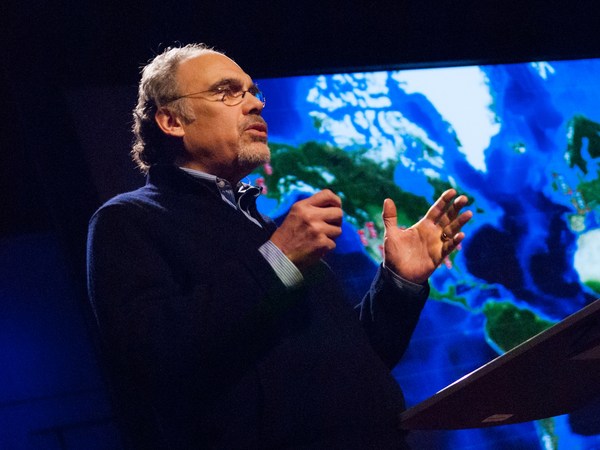Thank you very much. When I was a boy, my parents would sometimes take me camping in California.
We would camp in the beaches, in the forests, in the deserts. Some people think the deserts are empty of life, but my parents taught me to see the wildlife all around us, the hawks, the eagles, the tortoises. One time when we were setting up camp, we found a baby scorpion with its stinger out, and I remember thinking how cool it was that something could be both so cute and also so dangerous.
After college, I moved to California, and I started working on a number of environmental campaigns. I got involved in helping to save the state's last ancient redwood forest and blocking a proposed radioactive waste repository set for the desert. Shortly after I turned 30, I decided I wanted to dedicate a significant amount of my life to solving climate change. I was worried that global warming would end up destroying many of the natural environments that people had worked so hard to protect. I thought the technical solutions were pretty straightforward - solar panels on every roof, electric car in the driveway - that the main obstacles were political. And so I helped to organize a coalition of the country's biggest labor unions and biggest environmental groups. Our proposal was for a 300-billion-dollar investment in renewables. And the idea was not only would we prevent climate change, but we would also create millions of new jobs in a very fast-growing high-tech sector. Our efforts really paid off in 2007, when then-presidential candidate Barack Obama embraced our vision. And between 2009 and 2015, the US invested 150 billion dollars in renewables and other kinds of clean tech. But right away, we started to encounter some problems. So first of all, the electricity from solar rooftops ends up costing about twice as much as the electricity from solar farms. And both solar farms and wind farms require covering a pretty significant amount of land with solar panels and wind turbines and also building very big transmission lines to bring all that electricity from the countryside into the city. Both of those things were often very strongly resisted by local communities, as well as by conservation biologists who were concerned about the impacts on wild-bird species and other animals. Now, there was a lot of other people working on technical solutions at the time. One of the big challenges, of course, is the intermittency of solar and wind. They only generate electricity about 10 to 30 percent of the time during most of year. But some of the solutions being proposed were to convert hydroelectric dams into gigantic batteries. The idea was that when the sun was shining and the wind was blowing, you would pump the water uphill, store it for later, and then when you needed electricity, run it over the turbines. In terms of wildlife, some of these problems just didn't seem like a significant concern. So when I learned that house cats kill billions of birds every year, it put into perspective the hundreds of thousands of birds that are killed by wind turbines. It basically seemed to me at the time that most, if not all, of the problems of scaling up solar and wind could be solved through more technological innovation. But as the years went by, these problems persisted and, in many cases, grew worse. So California is a state that's really committed to renewable energy, but we still haven't converted many of our hydroelectric dams into big batteries. Some of the problems are just geographic; it's just you have to have a very particular kind of formation to be able to do that, and even in those cases, it's quite expensive to make those conversions. Other challenges are just that there's other uses for water, like irrigation,
and maybe the most significant problem is just that in California the water in our rivers and reservoirs is growing increasingly scarce and unreliable due to climate change. In terms of this issue of reliability, as a consequence of it, we've actually had to stop the electricity coming from the solar farms into the cities because there's just been too much of it at times. Or we've been starting to pay our neighboring states, like Arizona, to take that solar electricity. The alternative is to suffer from blowouts of the grid. And it turns out that when it comes to birds and cats - cats don't kill eagles; eagles kill cats.
What cats kill are the small common sparrows and jays and robins, birds that are not endangered and not at risk of going extinct. What do kill eagles and other big birds, like this kite as well as owls and condors and other threatened and endangered species, are wind turbines; in fact, they're one of the most significant threats to those big bird species that we have. We just haven't been introducing the airspace with many other objects like we have wind turbines over the last several years. And in terms of solar,
you know, building a solar farm is a lot like building any other kind of farm: you have to clear the whole area of wildlife. So this is a picture of one third of one of the biggest solar farms in California, called Ivanpah. In order to build this, they had to clear the whole area of desert tortoises, literally pulling desert tortoises and their babies out of burrows, putting them on the back of pickup trucks, and transporting them to captivity, where many of them ended up dying. And the current estimates are that about 6,000 birds are killed every year, actually catching on fire above the solar farm and plunging to their deaths.
Over time, it gradually struck me that there was really no amount of technological innovation that was going to make the sun shine more regularly or wind blow more reliably; in fact, you could make solar panels cheaper, and you could make wind turbines bigger, but sunlight and wind are just really dilute fuels, and in order to produce significant amounts of electricity, you just have to cover a very large land mass with them. In other words, all of the major problems with renewables aren't technical, they're natural. Well, dealing with all of this unreliability and the big environmental impacts obviously comes at a pretty high economic cost. We've been hearing a lot about how solar panels and wind turbines have come down in cost in recent years, but that cost has been significantly outweighed by just the challenges of integrating all of that unreliable power onto the grid. Just take, for instance, what's happened in California. At the period in which solar panels have come down in price very significantly, same with wind, we've seen our electricity prices go up five times more than the rest of the country. And it's not unique to us. You can see the same phenomenon happened in Germany, which is really the world's leader in solar, wind and other renewable technologies. Their prices increased 50 percent during their big renewable-energy push. Now you might think, well, dealing with climate change is just going to require that we all pay more for energy. That's what I used to think. But consider the case of France. France actually gets twice as much of its electricity from clean zero-emission sources than does Germany, and yet France pays almost half as much for its electricity. How can that be? You might have already anticipated the answer. France gets most of its electricity from nuclear power, about 75% in total. And nuclear just ends up being a lot more reliable, generating power 24 hours a day, seven days a week, for about 90% of the year. We see this phenomenon show up at a global level. So, for example, there's been a natural experiment over the last 40 years, even more than that, in terms of the deployment of nuclear and the deployment of solar. You can see that at a little bit higher cost, we got about half as much electricity from solar and wind than we did from nuclear. Well, what does all this mean for going forward? I think one of the most significant findings to date is this one. Had Germany spent 580 billion dollars on nuclear instead of renewables, it would already be getting a hundred percent of its electricity from clean energy sources, and all of its transportation energy. Now I think you might be wondering, and it's quite reasonable to ask: Is nuclear power safe? And what do you do with the waste? Well, those are very reasonable questions. Turns out that there's been scientific studies on this going over 40 years. This is just the most recent study, that was done by the prestigious British medical journal Lancet, finds that nuclear power is the safest. It's easy to understand why. According to the WHO, about 7 million people die annually from air pollution. And nuclear plants don't emit that. As a result, the climate scientist James Hansen looked at it. He calculated that nuclear power has already saved almost two million lives to date. It turns out that even wind energy is more deadly than nuclear. This is a photograph taken of two maintenance workers in the Netherlands, shortly before one of them fell to his death to avoid the fire, and the other one was engulfed in flames. Now, what about environmental impact? I think a really easy way to think about it is that uranium fuel, which is what we used to power nuclear plants, is just really energy dense. About the same amount of uranium as this Rubik's Cube can power all of the energy you need in your entire life. As a consequence, you just don't need that much land in order to produce a significant amount of electricity. Here you can compare the solar farm I just described, Ivanpah, to California's last nuclear plant, Diablo Canyon. It takes 450 times more land to generate the same amount of electricity as it does from nuclear. You would need 17 more solar farms like Ivanpah in order to generate the same output as Diablo Canyon, and of course, it would then be unreliable. Well, what about the mining and the waste and the material throughput. This has been studied pretty closely as well, and it just turns out that solar panels require 17 times more materials than nuclear plants do, in the form of cement, glass, concrete, steel - and that includes all the fuel used for those nuclear plants. The consequence is that what comes out at the end, since its material throughput, is just not a lot of waste from nuclear. All of the waste from the Swiss nuclear program fits into this room. Nuclear waste is actually the only waste from electricity production that's safely contained and internalized. Every other way of making electricity emits that waste into the natural environment, either as pollution or as material waste. We tend to think of solar panels as clean, but the truth is that there is no plan to deal with solar panels at the end of their 20 or 25-year life. A lot of experts are actually very concerned that solar panels are just going to be shipped to poor countries in Africa or Asia, with the rest of our electronic-waste stream, to be disassembled, often exposing people to really high level of toxic elements, including lead, cadmium and chromium, elements that because they're elements, their toxicity never declines over time. I think we have an intuitive sense that nuclear is a really powerful strong energy source and that sunlight is really dilute and diffuse and weak, which is why you have to spread solar collectors or wind collectors over such a large amount of land. Maybe that's why nobody was surprised when in the recent science-fiction remake of Blade Runner, the film opens with a very dark dystopian scene where California's deserts have been entirely paved with solar farms. All of which, I think, raises a really uncomfortable question: In the effort to try to save the climate, are we destroying the environment? The interesting thing is that over the last several hundred years, human beings have actually been trying to move away from what you would consider matter-dense fuels towards energy-dense ones. That means, really, from wood and dung towards coal, oil, natural gas, uranium. This is a phenomenon that's been going on for a long time. Poor countries around the world are in the process still of moving away from wood and dung as primary energies. And for the most part, this is a positive thing. As you stop using wood as your major source of fuel, it allows the forests to grow back and the wildlife to return. As you stop burning wood in your home, you no longer need to breath that toxic smoke. And as you go from coal to natural gas and uranium as your main sources of energy, it holds out the possibility of basically eliminating air pollution altogether. There's just this problem with nuclear - While it's been pretty popular to move from dirtier to cleaner energy sources, from energy-diffuse to energy-dense sources, nuclear is just really unpopular for a bunch of historical reasons. And as a consequence, in the past, I and I think a lot of others have sort of said, "In order to deal with climate change, we're just going to need all the different kinds of clean energy that we have." The problem is that it just turns out not to be true. You remember, I discussed France a little bit ago. France gets most of its electricity from nuclear. If France were to try to significantly scale up solar and wind, it would also have to significantly reduce how much electricity it gets from nuclear. That's because in order to handle the huge variability of solar and wind on the grid, they would need to burn more natural gas. Think of it this way, it's just really hard to ramp up and down a nuclear plant whereas I think we're all pretty familiar with turning natural gas up and down on our stove. A similar process works in managing the grid. Of course, it goes without saying that oil and gas companies understand this pretty well, which is why we've seen them invest millions of dollars in recent years in promoting solar and wind. This just raises, I think, another challenging question, which is that in places that are using a lot of nuclear - half of their grids that are mostly nuclear and hydro - going towards solar and wind and other renewables would actually increase carbon emissions. I think a better alternative is just to tell the truth. That's what a number of scientists have been doing. I mentioned earlier that hundreds of thousands of birds are killed every year by wind turbines; what I didn't mention is that a million bats, at a minimum, are killed every year by wind. The consequence has been that bat scientists have been speaking out about this. This particular bat species, the hoary bat, which is a migratory bat species, is literally at risk of going extinct right now because of the significant expansion of wind. It's not just wind, it's also on solar. The scientists who were involved in creating the Ivanpah solar farm, who were involved in clearing that land, have been speaking out. One of them wrote, "Everybody knows that translocation of desert tortoises doesn't work. When you're walking in front of a bulldozer, crying and moving animals and cacti out of the way, it's hard to think that the project is a good idea." And now we can see these phenomena at work at an international level. In my home state of California, we've been stuffing a lot of natural gas into the side of a mountain in order to handle all that intermittent solar and wind. It's sprung a leak. It was equivalent to putting 500,000 cars on the road. And currently in Germany, there's protesters trying to block a new coal mining project that would involve destroying the ancient Hambacher Forest in order to get to the coal underneath, all in an effort to phase out nuclear and expand solar and wind. The good news is that I think that people still care about nature enough for these facts to matter. We saw last year in South Korea a citizen's jury deliberated for several months weighing these different issues. They had to decide whether they were going to phase out nuclear or keep it and expand it. They started out 40% in favor of expanding nuclear, but after several months and considering these issues, they ended up voting 60% to expand nuclear. A similar phenomenon just happened last week in Arizona. The voters had a ballot initiative to vote on whether or not to continue with nuclear or to phase it out and try to replace it with natural gas and solar. They ended up rejecting at 70 to 30. And even here in Europe, we saw the Netherlands is one of the first countries in recent memory to actually announce, as they did last week, that they're going to start to increase their reliance on nuclear power in recognition that there's just no way they could generate significant amounts of energy enough from solar and wind to meet their climate targets. I think it's natural that those of us that became very concerned about climate change, such a big environmental issue, would gravitate towards really romantic solutions like harmonizing human civilization with the natural world using renewable energies. But I think it's also understandable that as the facts have come in, many of us have started to question our prior beliefs and change our minds. For me the question now is, Now that we know that renewables can't save the planet, are we going to keep letting them destroy it? Thank you very much. (Applause)
